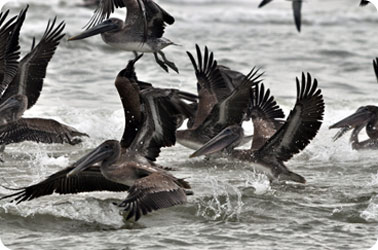It’s been a ritual for three decades. Every other day, circumstances permitting, a scientist from the University of Texas Marine Science Institute patrols a stretch of beach on Mustang Island, near the town of Port Aransas. Tony Amos notes the weather conditions, counts the number of people and cars, and lists the trash he finds. Most important, though, he counts the birds: herons, gulls, plovers, pelicans, and many others -- more than four million birds in all.
 Brown pelican numbers are increasing on Mustang Island. Credit: A.F. Amos
Brown pelican numbers are increasing on Mustang Island. Credit: A.F. AmosBut many of those bird species are a lot less prevalent today than when Amos began his work in 1978. Amos and his colleagues suspect that’s because there are a lot more people on the beaches.
When the survey began, the beach was undeveloped. Today, it’s lined with condos, houses, and other development. The number of cars on the beach has almost doubled, and the number of people has quadrupled.
Over that same span, 10 of the 28 bird species he’s counted have shown major declines in abundance, including plovers, terns, and cormorants. But four other species have actually shown major increases. That includes the brown pelican, which until last year was listed as an endangered species.
The researchers suggest that some of the birds may simply have moved to beaches with fewer people, where they compete with birds that already lived there. But when their work is combined with other studies, it shows that many of the birds may be disappearing -- their numbers thinned by the relentless encroachment of people on the Texas beach.

